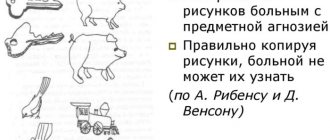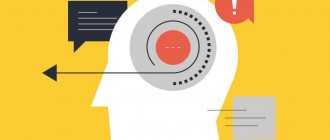Modality is one of the multifunctional concepts that have found application in various scientific fields. The categories of sensory modality are actively used in psychology and are reference points for ways of interacting with the client’s reality in neurolinguistic programming (NLP).
How can we use submodalities
By controlling submodalities, we can control assessment. That is, change the assessment of a situation from unpleasant to pleasant (or vice versa), remove obsessions (for example, overeating and smoking - obsessions), turn confusion into understanding, create and destroy beliefs and many, many more interesting things
Our attention is also controlled using submodalities. This is his “command language”
Knowing this language, you can do whatever you want with attention. For example, we focus on a subject, usually making it sharper and brighter, and turning everything else into a gray “background”. By changing the submodalities of perception of the current situation, you can do a lot of very funny things: control your state, remove unnecessary things (for example, not hear disturbing noise), notice what others miss, tune in only to what is happening outside, or completely immerse yourself. In addition, submodalities are a “command language” for managing our emotions and states. Knowing this language, you can evoke the desired state in yourself, create a new one, or reduce the intensity of an unpleasant emotion. You can control your creative state, get drunk without alcohol or a hangover, or stay completely awake for several days.
List of submodalities
The following is a list of submodalities and possible questions that can identify them.
Visual
| Position | Where is the picture? Where is this image located in space? Show the location of the image with your hands. Is the picture left or right of center? Is this picture slanted? |
| Distance | How close (far) is the image from you? Try to show the distance to the image with your hand. |
| Color – b/w | Is it color or black and white? Are there colors in the picture? |
| Colors | What colors are in this image? Are the colors vibrant, bright or faded? |
| Brightness | Is this picture rather bright or dark? In this context, is it brighter or darker than usual? |
| Focus | Is this image sharp or is it blurry? Is the picture in focus or blurry? |
| Detail | How detailed is this image? Are there many or few details? Do you only see general outlines or can you discern details? |
| Background | Is there a background? |
| Form | What shape is this picture - round, square, rectangular? |
| Association - dissociation | Do you see yourself from the outside or look at everything with your own eyes? If dissociation: Do you see yourself on the right, left or above? Can you see your face or your back? |
| Panoramic | Are you inside the image? Does the picture surround you or do you see it from the outside? |
| Border | Does this picture have borders or are the edges blurry? Does the border have a color? How wide is this limit? |
| Movement | Is this a movie or a slide (photography)? Is there movement in this image or is it static? How fast is this movement? |
| Proportions | Are the sizes of people and things in this picture normal, or is there something larger/smaller? |
| Dimension | Is it flat or voluminous? |
Auditory
| Position | Do you hear it from inside or outside? Is the sound source located inside you? Where is this sound coming from? |
| Height | What is the pitch of the sound? Is the sound more high-pitched or low-pitched? |
| Volume | What's the volume of this? Is the sound loud or quiet? |
| Mono/stereo | Surround sound? Do you hear it from one side, from both sides, or does the sound surround you? |
| Monotone | Is it a monotonous sound or a melody? |
| Pace | Is it fast or slow? |
| Rhythm | Does this sound have rhythm? If there is, try to show it by moving your palm. |
| Duration | Is it continuous or intermittent? |
Kinesthetic
| Quality | How would you describe the body sensations: trembling, tingling, warmth, cold, vibration, relaxation, tension... |
| Intensity | How strong is this feeling? |
| Position | Where is this feeling located? Show with your hand the location of this. |
| Movement | Is this sensation moving or static? Is this movement continuous or does it occur in waves? |
| Direction | Where does this movement start from? What is the direction of its movement? How does it come from its place of origin to the place where you are most aware of it? |
| Speed | Does the sensation move quickly or slowly? Are there jerks or is it a smooth movement? |
| Size | Is this sensation of a stable size or expanding (contracting)? |
I see, I hear, I feel
Do you know which type of perception is dominant for you? Here are some of the simplest questions:
What is more important to you: to be beautiful or comfortable? Is it important for you that the hall where you listen to music performed by the orchestra is beautifully decorated, or does the music completely compensate for all the shortcomings in the design of the hall? When you touch a person, does it matter what their voice sounds like? Is it easier for you to absorb information by reading or listening to it? How do you decide whether to trust this person or not? Are you listening to your inner feelings? Do you listen to how he speaks and catch some important notes in his intonations? Or do you look into his eyes and try to read something important there for you?
As you answer these questions, you will find that your answers are one of the following:
You have a primary sensory channel through which you absorb information.
There are three of them, and each is responsible for its own flow of images: if it is important for you to SEE, the visual (or visual) channel dominates, if it is important for you to LISTEN and HEAR, the auditory channel dominates,
if your internal and external sensations or, in other words, intuition and touch are important to you, then the kinesthetic channel dominates;
You have not one, but two active channels at once through which it is convenient for you to perceive information (for example, visual + kinesthetic); You prefer to receive information through one channel (for example, read), and transmit it through another (for example, not write, but tell).. If your answer corresponds to the first option, then we can conclude that you are a person of a very specific sensory type: visual , auditory or kinesthetic
If your answer corresponds to the first option, then we can conclude that you are a person of a very specific sensory type: visual, auditory or kinesthetic.
If your answer corresponds to the second option, then you can be classified as a mixed type, for which not one sensation is important, but two. Finally, choosing the third option means that your sensory system is tuned differently to perceive information and to transmit it
You perceive the world using one modality, and communicate with it using another
Finally, choosing the third option means that your sensory system is configured differently to receive information and to transmit it. You perceive the world using one modality, and communicate with it using another.
These, in general, are the principles proposed by the developers of NLP (neuro-linguistic programming), which allow us to answer the question of how to determine a person’s modality.
Block 2. Sensation. Definition.
Sensation is a reflection in the human psyche of individual properties of objects of the classical material world as a result of their impact on the receptors of the sense organs.
Druzhinin V.N. with colleagues designated sensation as a process of primary information processing at the level of individual properties of objects and phenomena. The material substrate of the human psyche is the brain. So in humans, the greatest representation is in the cerebral cortex, i.e. the largest projection space is occupied by sensations received through the eyes, ears, mouth, and hands. A stimulus from the conditionally objective world affects receptors - cells that specialize in isolating the corresponding properties from the entire variety, then along the ascending nerve pathways the nerve impulse as electrical waves and chemical reactions enters the human brain, where the received information is processed in its various parts and sensations are born.
Man differs significantly in his ability to extract sensations from the world from other representatives of the animal world. Thus, bats navigate in complete darkness using ultrasound, moving accurately in the labyrinths of caves. Birds cover thousands of kilometers, picking up the magnetic field of our planet. Snakes in complete darkness distinguish the thermal radiation of the prey in infrared light.
What is modality?
Modality is (lat. modus - mood, method, measure) - a method of action or attitude expressed towards action. Modality is a term originally used in the linguistic environment by Charles Bally and denoted a subjective assessment (modus) in relation to a dictum (presented material, text, expression). Subsequently, the concept of modality began to be used in psychology to explain the categories of the human sensory system and in philosophy - as a reflection of ways of being and phenomena. Modality is also used in such areas as:
- Computer systems are a multi-window program interface, where one of the windows is central and the user focuses on it.
- Music uses a modal scale from which other modes are built.
- Sociology. In the sociological typology of people, a modal person or a modal personality is the actually predominant type in a given society.
Types of alethic modality
They are represented by the following restrictions:
- Problematic (judgment regarding the possibility of an event occurring). Now the above example takes the following form: In Russia, reforms can be carried out in relation to the Armed Forces. Assertoric (judgments about a really existing fact). For example: In Russia, the Armed Forces are currently undergoing reform. As can be seen from the example, there is no expression of modality, but only the immediate fact of what is happening is stated.
- Apodictic (judgments regarding the necessity of an event). Example: In Russia it is necessary to carry out a number of reforms in relation to the Armed Forces.
How modality is studied in psychology
The modality of sensations has been studied in psychology for a long time. Actually, the very first scientific experiments of W. Wundt, with whom experimental psychology began its history, were devoted specifically to the measurement of sensitivity.
The most important sensations in human life are visual. Their significance can be judged by the following fact. To earn the proud name “Hawkeye,” the Indian had to have vision that would allow him to distinguish between the two stars located in the middle of the handle of the Big Dipper’s bucket. Visual acuity depends on the size of the angle between objects that a person can distinguish. The human eye is capable of distinguishing several hundred thousand colors and tones. And we can see the light of a candle 27 km away, provided the air is clear and clean. And, nevertheless, the German physicist G. Helmholtz, who studied the structure of the human eye in the mid-19th century, expressed many complaints about the imperfections of this organ.
Next in importance are the auditory sensations, which perceive the pitch, timbre and volume of sounds. The brain center separates sounds (an informative signal from a background noise), then detects repeating elements and, ultimately, identifies it, i.e.
recognizes.
Taste and smell are still a psychological mystery. First, it is surprising how large individual differences are in these areas. Perfumers are able to restore the composition of the aroma by smell. And many men, when choosing perfume for their beloved lady, will agree that “it’s not difficult to confuse everyone here: all corks smell the same.” Secondly, science has not yet been able to create artificial smell and taste recognizers. Tasters cannot yet be replaced by any artificially created device.
Tactile sensations carry signals for a person such as warm-cold, painful-not painful, soft-hard. Different receptors are responsible for touch, pain and temperature sensations. And they are located in different parts of the body with varying degrees of frequency. Therefore, the back, for example, will feel the cold faster than the stomach. The skin under the nose is more sensitive to pain than on the surface of the palm. And touching with your fingertips will tell you more about the surface of an object than if you touch with your elbow.
Kinesthetic channel of perception
This is a modality of sensations, that is, bodily perception, which is designated as “somatic sensations.” They, in turn, are divided into internal (pain, relaxation and tension, muscle feeling, sensation of movement and posture, work of internal organs) and external (temperature (cold and heat), vibration, pressure).
Kinesthetic channels of perception are closely intertwined with emotions, which reflect the same internal sensations, and are verbally described in the same way as they are. For example, “light at heart.”
There is also an osmic modality of sensations (olfactory - taste and smell). Most often, this channel of perception is combined with the kinesthetic one. However, smell and taste belong to completely different perception systems, but still a person analyzes them simultaneously, and in this regard they are grouped together. An example would be the expressions: “delicate taste”, “sweet smell”, etc.
Without smell, the entire flavor palette is significantly lost. In practice, this can be confirmed by the common phenomenon when a person with an impaired sense of smell (nasal congestion) takes food that seems tasteless and insipid to him, although the organ responsible for taste functions normally.
What are submodalities
Have you ever wondered how you know what you like about this food and not that one? Do you believe in this, but not at all in this strange thing? That this situation from childhood is pleasant, but do you like this person? The brain uses so-called sensory differences in the presentation of information to encode attitudes. For example, an unpleasant situation in the past may be dark, small, located at the bottom left, static and rectangular. And a pleasant situation in the past is bright, large, oval, right in front of your eyes and there may be movement in it.
Modalities in NLP (and psychology) are the channels for obtaining information: vision - visual modality, hearing - auditory, sensations - modality, speech - digital. Submodalities are then differences within a modality. Brightness, size, position, colors, focus of an image are submodalities of the visual channel. In the same way, there are submodalities of the auditory channel: volume, timbre, stereo/mono. The kinesthetic channel also has its own submodalities: sensations have size, intensity, quality (vibration, compression, cold, expansion) and location.
Submodalities of obsession: a clear bright object on a blurred or absent background, which occupies almost the entire area of the picture.
How do subpersonalities differ from modalities?
The concept of subpersonality in psychology is a metaphor about several beings within a person. Subpersonalities are tied to a person’s roles: social, professional, family, and use various modalities at their discretion. When comparing subpersonality with modality, it is more appropriate to use the term submodality. Modality and submodality are complementary concepts. Unlike modalities, submodalities are nuances and differences within a certain type of modality: lighter-darker, quieter-louder, movement-static.
Modality in philosophy
A type of being in connection with conditioned circumstances. What does modality mean in philosophy? This issue was studied by the Russian professor of philosophy M.N. Epstein. In his work “Philosophy of the Possible. Modalities in thinking and culture,” the scientist proposed dividing modalities into 3 types, depending on the predicates used in speech:
- Optical (existential)
– “to be able” and “to be”. These are different degrees of power in relation to being (it can be or happen, but it can not be and will not happen). - Pure (potential)
- modalities of abilities: “be able” - “not be able” (may not eat, may not drink, may not play an instrument) - Epistemic (cognitive)
– formed by the predicates “to be able” and “to know”. The modal judgments of ancient Greek philosophers: Socrates “I know that I know nothing” and Plato “I know what I have never known (did not know)” reflect the essence of cognitive modality in philosophy.
Modality of judgments
This is, to a certain extent, additional information expressed in the corresponding judgment regarding its logical or actual status, as well as evaluative, regulatory, temporal and other characteristics.
The modality of judgments is represented by such important and most common varieties as:
- alethic;
- epistemic;
- deontic;
- axiological.
Do we hear, see, touch?
A mature personality is guided by all five “tools” of perception. This is how she discovers the most complete picture of the world. However, whether a person wants it or not, most often he prefers one method of perception (sometimes several) to others. It turns out that he first “hears” the world, or he needs to first touch, be touched, and only then will he be ready to listen. Provided he liked the sensation. Psychology calls this phenomenon the modality of perception. But what is it and why does a person need to know which sense organs prevail in the awareness of what is happening?
People perceive the world in five main ways using their senses:
- hearing;
- vision;
- sense of smell;
- touch;
- taste.
The brain transforms the information obtained in this way, called sensory, into a certain representation, a certain model, which serves as a picture of the world. This phenomenon is reflected in the ancient parable of the three blind wise men who tried to imagine an elephant. One felt his trunk, another his leg, and the third his tail. It is clear that their definitions of the same subject differed. Since they were deprived of vision, they could not get a complete picture and foresee that the elephant was dangerous. All three were guided by the kinesthetic modality - they perceived the world by touch and thought in images.
Thus, there are several models of perception and processing of information coming from the outside, which are typical for most people. And even sighted people sometimes rely more on their senses of touch, internal sensations called intuition, than on their eyes. Others pay more attention to what they see or hear. There are also categories of people who prefer to “smell” or “taste” the world. But these are less common than those who prefer to look or touch.
Definition of epistemic modality
It characterizes the degree of truthfulness of knowledge. Epistemic modality is information expressed through a judgment regarding the grounds for its acceptance and the degree of validity. That is, in the process of exchanging information during communication between people, a clear awareness of the reasons for accepting or not accepting assessments, opinions, factual data, etc. expressed through statements is assumed.
The decision to accept a statement is influenced by many objective and subjective, external and internal factors, the most important of which are logical (the basis is the opinions of judgments that express faith) and extra-logical (judgments that are logically justified and express knowledge). The manifestation of this modality of perception occurs through the words: “unprovable”, “refuted”, “proven”, etc.
Is it possible to develop your sensitivity?
Yes. Actually, this is what happens among professionals who train their ear for music, or sense of smell, or color discrimination. Sensitivity can be trained. A trained person is able to distinguish up to 40 shades of black. This is what distinguished and proud fabric dyers.
And a person’s reward for the subtlety of sensations is the different sides of the world that open up to him with new facets. By developing the ability to distinguish shades of colors or musical phrases of complex shapes, a person develops his artistic abilities. Having learned to differentiate taste sensations, he becomes able to enjoy the subtlest shades of taste of coffee, or cognac, or wine, or a culinary masterpiece.
On the contrary, the absence of such taste sensitivity is replaced by a habit of obvious taste. And then for a person, the most delicious thing for the rest of his life remains only what he is accustomed to.
Main types of modalities
When a person uses tactile sensations, feelings, feels, touches, touches to understand and understand the surrounding reality, he uses the kinesthetic modality. There are also visual and auditory representational systems. Some people rely on internal sensations and are focused on internal dialogue. This modality is called auditory-digital, but it is as rare as olfactory or gustatory.
The classification of representative systems (modalities) is based on the sense organ, which most often determines a person’s attitude to what is happening.
Visuals
This is the name given to people who perceive information mostly visually. They are characterized by:
- maintaining social distance;
- making eye contact.
They are distinguished by:
- beautiful, neat handwriting;
- the desire for order everywhere and in everything.
Such people are little bothered by extraneous noise. However, it is difficult for them to perceive information by ear. Their speech is replete with words (whether verbs or adjectives) that are associated with vision. They “look”, “observe the picture”, use phrases:
- "at first sight";
- "it would seem that";
- “as you can see”;
- “I see that your position is correct;;
- “At least kill me, I don’t see the point in your reasoning.”
Audials
People who perceive the world “by ear” are identified by the habit of pronouncing words when they read or write. They do this, as a rule, silently, but at the same time they very noticeably move their lips and shake their heads. It seems that they are talking to themselves.
Other differences between people who have developed the auditory modality of perception:
- They imitate the voices of other people and the sounds of nature well.
- They are excellent at reciting.
- Distracted by noise.
- Words related to hearing are widely used. For example, they turn to others with the words “Listen.”
- They have a well-developed auditory memory.
- The gaze during communication is directed in the middle.
- When communicating, they often use words and expressions related to hearing. “I hear your despair”, “I hear that you are telling the truth.”
Kinesthetics
These people need to touch. For them, emotions and internal sensations play a significant role:
- When communicating, they often touch the other person.
- They accompany their speech with abundant gestures.
- They have lively facial expressions.
- They don't pay attention to the mess.
- They may write in illegible, sloppy handwriting.
- They love to twirl various objects in their hands, sometimes even chew them.
- Such people have developed bodily memory; they “remember” with their bodies.
- The dictionary is replete with expressions related to bodily sensations. “I feel that you are telling the truth,” “There is a sense of confidence in your reasoning.”
- They are more sensitive and emotional than auditory and visual learners.
Modality (type of perception): types and their definition.
Different people have different systems for receiving, processing information and forming images. The strategy for working with information consists of three successive stages:
- search;
- representation;
- grade.
That is, before communicating any information verbally, a person finds it in memory (search), processes it (representation), evaluates it (evaluation) and only then reports it using words. This whole process proceeds quite quickly.
The learning process begins with perception; it is with its help that the teacher establishes contact with the student. The syntonic model considers the process of transmitting and receiving information as the result of a complex interaction between the processes of perception and thinking (perception + thinking = communication). The syntonic model of communication (syntony - to be in harmony with oneself and others) is impossible without a state of harmony with oneself and the world around us.
Our senses are like five doors that we open to collect information about the surrounding reality. Our consciousness opens these “doors” in turn: for one person, first for pictures, then for smells, for another - first for sounds, then for touches. It's a very quick sequence, but a sequence nonetheless. Our subconscious mind perceives information through all five channels simultaneously and receives much more information than our conscious mind. The syntonic model is based on the idea that each person has his own “favorite door of perception” - that representative system that he trusts more than others. For example, if your favorite system is visual (visual), then you perceive and store the world in “pictures” in your memory. It has been established that the leading representative system is externally manifested in eye movements, choice of words used in communication, breathing patterns and even posture.
People represent their experiences differently. The sensory systems used in this case are called representation systems or representational systems
. The ways through which a person cognizes (represents) the world pass through the organs of vision, hearing, smell, taste, and kinesthetics. All these systems function continuously, but since most of the information turns out to be redundant for a number of reasons, a person pays attention only to that part of it that provides information that is most consistent with existing experience.
The system that is used to find the required information is called the leading one. Despite the fact that the search is carried out in only 1.5–2 s, it is this stage of the thinking process that determines the leading modality of a person.
The system by which it is decided whether known information is true or false is called a reference system .
There are three main types of perception (modalities): visual
(visual),
auditory
(hearing)
and kinesthetic
(sensitive
).
A person of a visual type perceives and organizes his experience and thinking primarily with the help of visual images. The auditory type represents and describes the world in auditory, auditory images. The third type - kinesthetic - perceives and evaluates the world with the help of sensations and feelings.
Any person naturally uses all channels for receiving information and builds images in all sensory systems. But at the same time, one of the named systems usually turns out to be leading, dominant. Knowing a person’s modality, you can choose the appropriate access keys to achieve rapport with him.
Rapport is a term (English rapport - return, bear fruit), meaning a deep feeling of mutual trust and ease, allowing partners to have good contact with each other.
Rapport (R) has the following characteristics:
1. People always know when they are in rapport, but they cannot always determine how they get there and what needs to be done if its level changes.
2. Rapport is impossible in conditions of interpersonal conflict.
3. To create rapport with another person, you must first of all be yourself in rapport. This state is called congruence
(congruens - lat. - to meet and agree), which means agreement and harmony in the inner world of a person.
Congruence gives power to words. Incongruity is caused by a mismatch between the flow of verbal and nonverbal information. Incongruity is not necessarily a lie; it can occur during shopping decisions (for example, 50 brands of televisions).
Access keys are specific nonverbal behaviors that indicate the method by which information is obtained.
Determining the modality of a person - a communication partner - is possible using a number of indicators, which include: ocular access signals (OAS), modal predicates, gestures, speech rate, voice intonation
(Table 1).
Table 1. Representative systems
| Indicators (signs) | Representational systems | |||
| Visualist | Kinesthetic | Audiologist | Digital | |
| Ocular access signals (OAS) (for the observer) | Up left, up right, up straight, straight ahead | Down to the left, sometimes down in front of you | Left, right, down right | To the side, to the right, head up |
| Modal predicates (words used) | picture, look, eye, vision, imagine, perspective, dark, foggy, brilliant, bright, apparently, look, observe, bright, admire | touch, touch, heavy, rough, contact, pressure, barrier, warm, flexible feel, feel | loud, clear, call, talk, discuss, ask, quiet, harmony, call, appeal, consonant, listen sound, hear, tone | analyze, understand, logically, argue, comprehend, meaning, conclusions |
| Signs | ||||
| Phrases | I see what you mean. You should look back. This project has bright prospects | I'm touching on interests. I will keep in touch. I can keep my finger on the pulse. This proposal stinks. Swallow someone's comments. | This sounds right. Something tells me that I need to tune in and listen. I want to express my opinion. Deafening blow | We need to figure it out. Let's analyze it. Systematize information. |
| Speech | Fast, loud, high pitch | Slow, quiet, low chest tone | Expressive, measured, melodic voice | Monotonous voice |
| Hand gestures | At the level of the head, neck, shoulders | At abdominal level | At chest level | At chest level |
| Pose | Head up, back straight | Back bent, head down | Head tilted to one side | Upright posture, arms crossed |
| Movements | Tense, sharp | Uninhibited | average | Monotonous |
| Breath | Shallow, top of the lungs | Deep breathing, lower abdomen | Even breathing, with all your chest | Shallow |
| Hearing Rules | "Seeing to Hearing" | "Feeling to Hearing" | "Don't see to hear" | No eye contact |
| Complexion | Paler during monologue | Turns pink during monologue | Normal during monologue | Normal during monologue |
The eye movements presented in Table 1 are typical for a right-handed person (in left-handed people all reactions will be the opposite).
The most effective indicator of modality determination is ocular access signals (lateral eye movements). When a person thinks, he makes movements with his eyes, which is associated with the activation of the work of various parts of the brain during the thinking process.
The movements of a person's eyes in situations where he is forced to remember, look for answers to difficult questions, and formulate thoughts is a reliable indicator of a person's dominant sensory system. Even if a person strives to look at the same point and control his gaze, this still cannot last long
The second indicator of a person's modality is language access keys or modal predicates
– typical words and expressions used by a person and reflecting the characteristics of his perception.
If you know which representational system your students prefer, you can use words that match their “favorite” perceptual model. People with a visual model of perception easily understand some words, while people with an auditory (auditory) and kinesthetic model easily understand others. If you choose and use words correctly, in accordance with the student’s leading representative system, then it will not only be easy for you to establish contact and mutual understanding, but also to convey the necessary information and teach.
How do you know which representational system a person prefers? To do this, you need to carefully watch him. The words he uses will say a lot. His nonverbal behavior will be even more eloquent: eye movements, tempo and timbre of voice, breathing, posture. This important information cannot be faked, it comes straight from the subconscious, it is only important to learn to recognize and use it.
How to measure sensitivity
Professionals are particularly sensitive to sounds, smells and colors. Only a trained musician can hear falsehood in the performance of a piece of music. An artist can distinguish color shades better than an amateur. Can these individual differences be measured?
Yes, and psychological research is aimed at measuring two types of sensitivity: absolute and difference.
Here is the easiest way to observe how people differ in hearing acuity. Sit them next to each other and ask them to close their eyes. Then slowly approach them with a ticking clock or metronome. The one who hears the sound earlier has higher absolute hearing sensitivity. And whoever first feels that the sound has become louder has a higher difference hearing sensitivity. A pattern derived by psychophysiologist S. Stevenson indicates that the weaker the signal that a person is able to perceive, the higher his sensitivity to this type of signal. And, conversely, with low sensitivity a person needs a signal of greater strength. This is why trained professionals differentiate sounds, smells and tastes so subtly - they are able to capture the subtlest shades and feel the slightest difference between signals of different strengths.
How to determine who is leading
To establish the dominant modality, a person must answer simple questions, for example:
Will a person wear clothes because they are beautiful but not very comfortable? What role does the decoration of the hall play if they came here to listen to music? Does it matter how the voice of the person you touch sounds? Does a person belong to those who need to see once rather than hear three times? Does a person trust strangers based on his inner feelings, is he guided by appearance, or is it important to him what the other says?
From the answers, it becomes clear what guides the individual, which channel he prefers to use for perceiving and processing information:
- The sloppy appearance and undecorated hall “scratch” the visual eye.
- The wonderful music completely compensates for the tasteless audio decorations.
- A kinesthetic student who is comfortably seated in a chair will not notice the design at all, but will not be able to enjoy the music until the seat is heated to a pleasant temperature.
How is it useful to know your leading perceptual system?
It is advisable for people to understand which modality is their leading one. This knowledge helps a person not only become an interesting conversationalist, but also allows him to master persuasion techniques:
- A person who is well versed in the modalities of perception understands others better, which means he can calm and convince his opponent faster and more effectively if necessary.
- Awareness of one’s own leading modality helps to “see through” an ill-wisher, an adventurer or simply a liar.
- A person who navigates his own system of perception will find a common language with his children.
- If the need arises to speak in public, knowing the leading modality will help you establish contact with the audience.
- Understanding yourself also leads to making the right, effective decisions.
In the parable of the elephant, the blind sages used only one channel of perception - kinesthetic - and were unable to understand what the “object” was. And the animal, in the end, crushed the scientists simply because they did not move away in time and did not give way to him. If wise people would connect the auditory channel of perception or use someone else's visual channel, they would quickly understand what an elephant is.
Strongly developed modalities help to perceive the world more colorfully, enjoy all manifestations of life, and benefit from situations and events that previously seemed harmful, useless, and boring.
Types of modality
It is a well-known fact that the nervous system of an individual person is individual and unique. The same is true with the so-called information food for her.
The following types of modality are distinguished:
- Visual – visual (pictures, color, visual images and light).
- Auditory – auditory (sounds, music, auditory images and intonations).
- Kinesthetic – tactile (touch, muscle and skin feeling, internal sensations).
- Logical - semantic, abstract, discrete (terms, reasoning, generalized concepts).
This perception channel is additional. Its peculiarity is the use of information obtained not from primary sensations. The logical view of the modality acts as a secondary sensory channel. But a person can process information received through primary channels in such a way that it loses all connections with them (semantic channel). It reflects the process of understanding information using abstract knowledge.
According to the Russian scientist I.P. Pavlova, logical modality is the second signaling system. Scientists most often strive to use this channel for communication; they try to activate it among schoolchildren.
For communication, the first three above-mentioned channels are of greatest importance. Almost every person has one channel of perception of existing information that prevails over others.
In this regard, there is a need to satisfy sensory hunger, but not with any information, but exclusively with that which is required by the leading modality of the individual.
For greater clarity, it is worth giving a clear example: to solve a given problem, one person will analyze the possible answers by sketching on paper, and another will speak them out loud, and a third will connect the objects at hand.
“I recognize a sweetheart by his gait”
Only a pronounced kinesthetic person could say that!
An internally oriented kinesthetic person most often even sits differently than others: with his arms and legs crossed, his head down, as if he is constantly listening to himself and his state.
For an externally oriented kinesthetic learner, for example, it is important:
- How they touch him, and what he himself touches;
- How tense are his muscles?
- What does his intuition tell him;
- Whether he is sitting, standing or walking.
So, you are a kinesthetic learner if most of the 10 conditions listed below are true for you:
A
To make an important decision, you
- often turn to your intuition;
- must make sure that nothing disturbs or worries you in the decision made;
- should experience a feeling of satisfaction from the solution found;
- Having compared the options, you clearly feel the attractiveness of one of them for you;
- must trust the one who offers this solution.
B. You will make your choice if
- you just feel like you like the choice you made;
- you feel trust;
- there are no vague feelings disturbing you that something is going wrong;
- you feel the tension subsiding from finding the right solution;
- if there is a feeling of joy from a job well done.
There are many different answers to the question of how to determine the modality of perception, and there are enough diagnostic techniques, tests and methods to figure it out. We showed only one of many options.
But it is equally important, having determined your type of perception, not to stop there, but to try to begin to develop other sensory abilities. Special simulators are useful for this, such as exercises for the development of figurative memory or figurative perception
Why adaptation is needed
The human brain is plastic, and if the sense organs are affected by a signal for a sufficiently long time, then the sensation generated by this signal gradually dulls and weakens. The adaptation mechanism is triggered.
You enter a dark room and at first you see nothing. Gradually, the eyes adapt to the darkness, and objects acquire distinct outlines. When you return to a well-lit room, you will again need time to adapt, this time to the light.
Now imagine that you left your home for a while and then returned. You enter a familiar room and the first impression is the extraordinary sharpness of all the objects located here. When you left, you didn’t experience this, but now you look back and are surprised: everything seems to be the same, but different. But after a while everything returns to normal again. This again triggered the adaptation mechanism, thanks to which the sensations seem to dull, losing their sharpness and brightness.
Maybe that’s why psychologists suggest that spouses who have ceased to feel a sense of novelty towards each other should separate for a few days, so that later, when they meet, they look at each other in a new way? To neutralize the adaptation, due to which the excitement from the aroma, image and touch of a loved one has gone. Somehow, imperceptibly, he or she has become a familiar element of the home.
Although adaptation does not serve the best purpose in the last example, it is nevertheless a very important biological mechanism. Man lives in a rapidly changing world and operates within a turbulent environment. Adaptation performs, first of all, an orienting function, helping to discard the usual familiar signals and focus on new ones. Therefore, while listening to music in a concert hall, you may well be distracted by your thoughts or the whisper of a neighbor, especially if the music does not captivate you.
Another adaptation function - protective - helps to adapt to strong stimuli and, ultimately, stop noticing them. This adaptive mechanism reduces our energy costs.
The types of sensations differ in the speed of adaptation. Olfactory and tactile receptors adapt faster than with visual and auditory sensations. Those who wear glasses and have the habit of sliding them onto their forehead know how easy it is to forget about them - adaptation to the tactile stimulus quickly occurs.
Exercise “How will I know”
The point of this exercise is not about how you calculate (for example, “mine is not mine”, this is a process of evaluation), but how you know about it. That is, after you have calculated, you somehow find out “mine is not mine.” Every time you look in the mirror, you don’t carry out complex “I am not me” calculations. You already know about this. How do you find out about this? Compare submodal differences:
| I | Not me |
| the image is brighter, clearer, more voluminous | image dimmer more blurry flat |
Visual channel
Me or not me
Imagine yourself in the middle of a group of people. How do the submodalities of your image differ from the submodalities of the people around you?
Whether you like the food or not.
Imagine that there are several dishes on the table that you like, and several that you would not eat. What is the difference between the submodalities of the image of “tasty” and “tasteless” food?
Mine is not mine.
Imagine that there are a dozen completely identical pens on the table. But one of them is yours. How does her performance differ from others?
Important - not important. Imagine two things (situations, people), one of which is important to you, the other is completely unimportant
What is the difference between the submodalities of the first and second image?
Imagine two things (situations, people), one of which is important to you, the other is completely unimportant. How do the submodalities of the first and second images differ?
Auditory channel
My voice and someone else's
Likewise. How do the submodalities of my voice (for example, tape recording) differ from the voice of another person.
Linguistic scope of application of this concept
Modality in language (English) is a certain characteristic that denotes probability, necessity, possibility.
There are five main modal verbs, four of which have the past tense form (indicated below through the corresponding “/” sign).
So, it’s worth listing them:
- can/could;
- may/might;
- shall/should;
- will/would;
- must / absent.
However, this concept is expressed not only through modal verbs, but also through modal adverbs, such as:
- likely (most likely);
- surely (probably);
- possibly (perhaps), etc.











